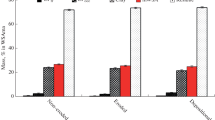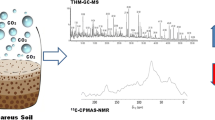Abstract
The chemical structure of different soil organic matter (OM) pools in water-stable macro- and free microaggregates isolated from the surface horizons of Haplic Chernozem in contrasting variants of land use (steppe and long-term bare fallow) is studied using solid-state 13C-NMR spectroscopy. It is observed that the degree of OM protection increases with a decrease in the size of structural units, which is confirmed by integral characteristics of OM chemical structure, such as lower degrees of OM decomposition, aromaticity, and hydrophobicity of microaggregates as compared with macroaggregates. A negative effect of the long-term bare fallow regime causes a sharp increase in the integral indicators of the chemical structure in all studied OM pools, being more pronounced in free microaggregates. The proposed multiple linear regression models for the C/N value prediction (\(R_{{adj}}^{2}\) = 0.993, P < 0.05 for discrete (free and occluded) OM and \(R_{{adj}}^{2}\) = 0.996, P < 0.05 for the clay-bound OM and the residue fraction) clearly explain its increase in the bare fallow, reflecting the maximum nitrogen losses in OM, which in its status approaches the degraded one. According to the proposed model, the size of clay particles is determined by a set of factors. The best model with all its parameters being significant (\(R_{{adj}}^{2}\) = 0.997, P < 0.05) clearly demonstrates that the average diameter of clay particles increases with a decrease in the amount of OM hydrophobic fragments, the share of smectites in clay, and increase in the content of the clay-bound carbon.



Similar content being viewed by others
REFERENCES
Z. S. Artemyeva, Abstract of Doctoral Dissertation in Biology (Moscow, 2008) [in Russian].
Classification and Diagnostics of Soils of the USSR (Kolos, Moscow, 1977) [in Russian].
B. M. Kogut, Z. S. Artemyeva, N. P. Kirillova, M. A. Yashin, and E. I. Soshnikova, “Organic matter of the air-dry and water-stable macroaggregates (2–1 mm) of haplic chernozem in contrasting variants of land use,” Eurasian Soil Sci. 52, 141–149 (2019). https://doi.org/10.1134/S106422931902008X
G. N. Fedotov and Z. S. Artem’eva, “Colloidal component of granulodensimetric soil fractions,” Eurasian Soil Sci. 48, 54–62 (2015). https://doi.org/10.1134/S1064229315010044
D. V. Khan, Organomineral Compounds and Soil Structure (Nauka, Moscow, 1969) [in Russian].
Z. Artemyeva, N. Danchenko, Yu. Kolyagin, N. Kirillova, and B. Kogut, “Chemical structure of soil organic matter and its role in aggregate formation in haplic chernozem under the contrasting land use variants,” Catena 204, 105403 (2021). https://doi.org/10.1016/j.catena.2021.105403
T. Asselman and G. Garnier, “Adsorption of model wood polymers and colloids on bentonites,” Colloids Surf., A 168, 175–182 (2000). https://doi.org/10.1016/S0927-7757(00)00430-1
J. A. Baldock, J. M. Oades, A. M. Vassallo, and M. A. Wilson, “Solid-state CP/MAS 13C NMR analysis of bacterial and fungal cultures isolated from a soil incubated with glucose,” Aust. J. Soil Res. 28, 213–225 (1990). https://doi.org/10.1071/SR9900213
M. H. Beare, M. L. Cabrera, P. F. Hendrix, and D. C. Coleman, “Aggregate-protected and unprotected pools of organic matter in conventional and no-tillage Ultisols,” Soil Sci. Soc. Am. J. 58, 787–795 (1994). https://doi.org/10.2136/sssaj1994.03615995005800030021x
H. Bossuyt, J. Six, and P. F. Hendrix, “Aggregate-protected carbon in no-tillage and conventional tillage agroecosystems using carbon-14 labeled plant residue,” Soil Sci. Soc. Am. J. 66, 1965–1973 (2002). https://doi.org/10.2136/sssaj2002.1965
C. A. Cambardella and E. T. Elliott, “Carbon and nitrogen distribution in aggregates from cultivated and native grassland soils,” Soil Sci. Soc. Am. J. 57, 1071–1076 (1993). https://doi.org/10.2136/sssaj1993.03615995005700040032x
A. M. Cates, M. D. Ruark, J. L. Hedtcke, and J. L. Posner, “Long-term tillage, rotation and perennialization effects on particulate and aggregate soil organic matter,” Soil Tillage Res. 155, 371–380 (2016). https://doi.org/10.1016/j.still.2015.09.008
C. Chenu and G. Stotzky, “Interactions between microorganisms and soil particles: an overview,” in Interactions Between Soil Particles and Microorganisms: Impact on the Terrestrial Ecosystem (Wiley, Chichester, 2002), pp, 3–39.
J. S. Clemente, A. J. Simpson, and M. J. Simpson, “Association of specific organic matter compounds in size fractions of soils under different environmental controls,” Org. Geochem. 42, 1169–1180 (2011). https://doi.org/10.1016/j.orggeochem.2011.08.010
N. N. Danchenko, Z. S. Artemyeva, Yu. G. Kolyagin, and B. M. Kogut, “Features of the chemical structure of different organic matter pools in haplic chernozem of the Streletskaya steppe: 13C MAS NMR study,” Environ. Res. 191, 110205 (2020). https://doi.org/10.1016/j.envres.2020.110205
E. T. Elliott, “Aggregate structure and carbon, nitrogen, and phosphorus in native and cultivated soils,” Soil Sci. Soc. Am. J. 50, 627–633 (1986). https://doi.org/10.2136/sssaj1986.03615995005000030017x
X. Feng, A. J. Simpson, and M. J. Simpson, “Chemical and mineralogical controls on humic acid sorption to clay mineral surfaces,” Org. Geochem. 36 (11), 1553–1566 (2005). https://doi.org/10.1016/j.orggeochem.2005.06.008
J. D. Jastrow, “Soil aggregate formation and the accrual of particulate and mineral associated organic matter,” Soil Biol. Biochem. 28, 656–676 (1996). https://doi.org/10.1016/0038-0717(95)00159-X
A. Golchin, J. M. Oades, J. O. Skjemstad, and P. Clarke, “Soil structure and carbon cycling,” Aust. J. Soil Res. 32, 1043–1068 (1994). https://doi.org/10.1071/SR9941043
A. Golchin, J. A. Baldock, and J. M. Oades, “A model linking organic matter decomposition, chemistry, and aggregate dynamic,” in Soil Processes and the Carbon Cycle (CRC Press, Boca Raton, FL, 1997), pp. 245–266.
S. Ghosh, Z.-Y. Wang, S. Kang, P. C. Bhowmik, and B. **ng, “Sorption and fractionation of a peat derived humic acid by kaolinite, montmorillonite and goethite,” Pedosphere 19 (1), 21–30 (2009). https://doi.org/10.1016/S1002-0160(08)60080-6
V. V. S. R. Gupta and J. J. Germida, “Distribution of microbial biomass and its activity in different soil aggregate size classes as affected by cultivation,” Soil Biol. Biochem. 20, 777–786 (1988). https://doi.org/10.1016/0038-0717(88)90082-X
P. G. Hatcher, M. Schnitzer, L. W. Dennis, and G. E. Maciel, “Aromaticity of humic substances in soils,” Soil Sci. Soc. Am. J. 45, 1089–1094 (1981). https://doi.org/10.2136/sssaj1981.03615995004500060016x
P. M. Huang, M. K. Wang, and C. Y. Chiu, “Soil mineral-organic matter-microbe interactions: Impacts on biogeochemical processes and biodiversity in soils,” Pedobiology 49, 609–635 (2005). https://doi.org/10.1016/j.pedobi.2005.06.006
H. Knicker, “Solid state CPMAS 13C and 15N NMR spectroscopy in organic geochemistry and how spin dynamics can either aggravate or improve spectra interpretation,” Org. Geochem. 42 (8), 867–890 (2011). https://doi.org/10.1016/j.orggeochem.2011.06.019
A. Kölbl and I. Kögel-Knabner, “Content and composition of free and occluded particulate organic matter in a differently textured arable Cambisol as revealed by solid-state 13C NMR spectroscopy,” J. Plant Nutr. Soil Sci. 167, 45–53 (2004). https://doi.org/10.1002/jpln.200321185
P. M. Kopittke, R. C. Dalal, C. Hoeschen, et al., “Soil organic matter is stabilized by organo-moneral associations through two key processes: the role of the carbon to nitrogen ratio,” Geoderma 357, 113974 (2020). https://doi.org/10.1016/j.geoderma.2019.113974
E. Lichtfouse, C. Chenu, F. Baudin, et al., “A novel pathway of soil organic matter formation by selective preservation of resistant straight-chain biopolymers: chemical and isotope evidence,” Org. Geochem. 28 (6), 411–415 (1998). https://doi.org/10.1016/S0146-6380(98)00005-9
S. Manzoni and A. Porporato, “Soil carbon and nitrogen mineralization: theory and models across scales,” Soil Biol. Biochem. 41, 1355–1379 (2009). https://doi.org/10.1016/j.soilbio.2009.02.031
S. Manzoni, J. A. Trofymow, R. B. Jackson, and A. Porporato, “Stoichiometric controls on carbon, nitrogen, and phosphorus dynamics in decomposing litter,” Ecol. Monogr. 80 (1), 89–106 (2010). https://doi.org/10.1890/09-0179.1
M. Mooshammer, W. Wanek, I. Haemmerle, et al., “Adjustment of microbial nitrogen use efficiency to carbon: nitrogen imbalances regulates soil nitrogen cycling,” Nat. Commun. 5, 3694 (2014). https://www.nature.com/naturecommunications.https://doi.org/10.1038/ncomms4694
C. Nicolás, T. Martin-Bertelsen, D. Floudas, J. Bentzer, M. Smits, T. Johansson, C. Troein, P. Persson, and A. Tunlid, “The soil organic matter decomposition mechanisms in ectomycorrhizal fungi are tuned for liberating soil organic nitrogen,” ISME J. 13, 977–988 (2019). https://doi.org/10.1038/s41396-018-0331-6
S. L. O’Brien and J. D. Jastrow, “Physical and chemical protection in hierarchical soil aggregates regulates soil carbon and nitrogen recovery in restored perennial grasslands,” Soil Biol. Biochem. 61, 1–13 (2013). https://doi.org/10.1016/j.soilbio.2013.01.031
S. M. F. Rabbi, B. R. Wilson, P. V. Lockwood, H. Daniel, and I. M. Young, “Aggregate hierarchy and carbon mineralization in two Oxisols of New South Wales, Australia,” Soil Tillage Res. 146, 193–203 (2015). https://doi.org/10.1016/j.still.2014.10.008
A. G. Seech and E. G. Beauchamp, “Denitrification in soil aggregates of different sizes,” Soil Sci. Soc. Am. J. 52, 1616–1621 (1988). https://doi.org/10.2136/SSSAJ1988.03615995005200060019X
A. J. Simpson, M. J. Simpson, W. L. Kingery, et al., “The application of 1H high-resolution magicangle spinning NMR for the study of clay–organic associations in natural and synthetic complexes,” Langmuir 22 (10), 4498–4503 (2006). https://doi.org/10.1021/la052679w
J. Six, E. T. Elliott, and K. Paustian, “Soil macroaggregate turnover and microaggregate formation: a mechanism for C sequestration under no-tillage agriculture,” Soil Biol. Biochem. 32, 2099–2103 (2000). https://doi.org/10.1016/S0038-0717(00)00179-6
H. Soinne, J. Hyväluoma, E. Ketoja, and E. Turtola, “Relative importance of organic carbon, land use and moisture conditions for the aggregate stability of post-glacial clay soils,” Soil Tillage Res. 158, 1–9 (2016). https://doi.org/10.1016/j.still.2015.10.014
J. M. Tisdall and J. M. Oades, “Organic matter and water-stable aggregates in soils,” J. Soil Sci. 33, 141–163 (1982). https://doi.org/10.1111/j.1365-2389.1982.tb01755.x
K. U. Totsche, W. Amelung, M. H. Gerzabek, et al., “Microaggregates in soils,” J. Plant Nutr. Soil Sci. 181 (1), 104–136 (2018). https://doi.org/10.1002/jpln.201600451
R. Wagai, L. M. Mayer, and K. Kitayama, “Nature of the “occluded” low-density fraction in soil organic matter studies: a critical review,” Soil Sci. Plant Nutr. 55 (1), 13–25 (2009). https://doi.org/10.1111/j.1747-0765.2008.00356.x
M. M. Wander and X. Yang, “Influence of tillage on the dynamics of loose- and occluded particulate and humified organic matter fractions,” Soil Biol. Biochem. 32, 1151–1160 (2000). https://doi.org/10.1016/S0038-0717(00)00031-6
A. Wild, Russell’s Soil Conditions and Plant Growth (Wiley, Chichester, 1988).
IUSS Working Group WRB, World Reference Base for Soil Resources 2014, International Soil Classification System for Naming Soils and Creating Legends for Soil Maps, World Soil Resources Reports No. 106 (UN Food and Agriculture Organization, Rome, 2014).
S. Xu, M. L. Silveira, L. W. Ngatia, A.E. Normand, et al., “Carbon and nitrogen pools in aggregate size fractions as affected by sieving method and land use intensification,” Geoderma 305, 70–79 (2017). https://doi.org/10.1016/j.geoderma.2017.05.044
Author information
Authors and Affiliations
Corresponding author
Ethics declarations
The authors declare that they have no conflicts of interest.
Additional information
Translated by G. Chirikova
Rights and permissions
About this article
Cite this article
Artemyeva, Z.S., Danchenko, N.N., Kolyagin, Y.G. et al. Chemical Structure of the Organic Matter of Water-Stable Structural Units in Haplic Chernozem under Contrasting Land Uses: Solid-State CP-MAS 13C-NMR Spectroscopy. Eurasian Soil Sc. 55, 734–744 (2022). https://doi.org/10.1134/S1064229322060035
Received:
Revised:
Accepted:
Published:
Issue Date:
DOI: https://doi.org/10.1134/S1064229322060035




